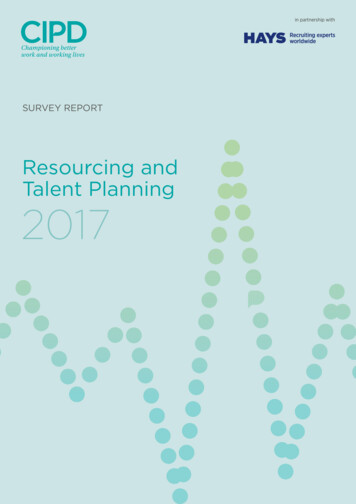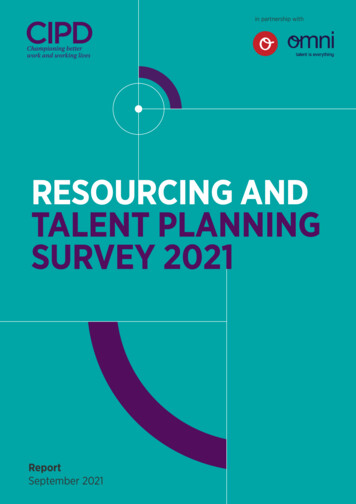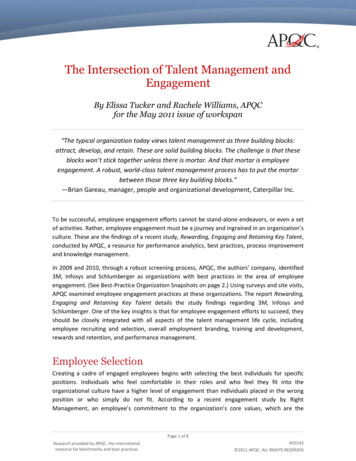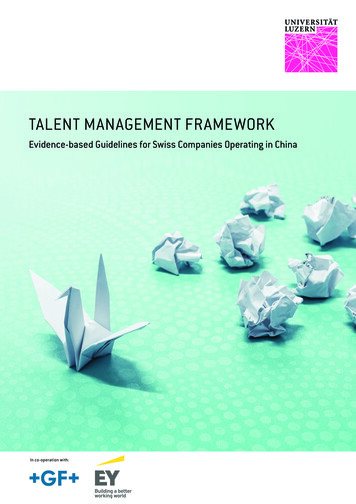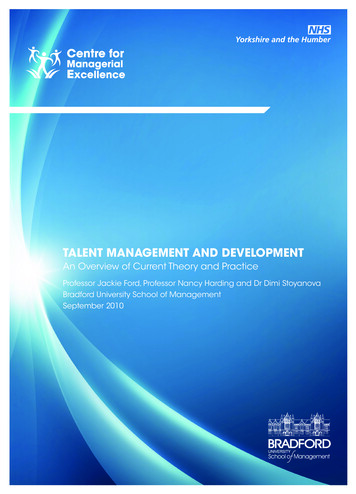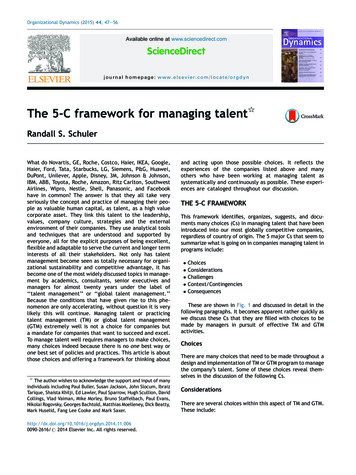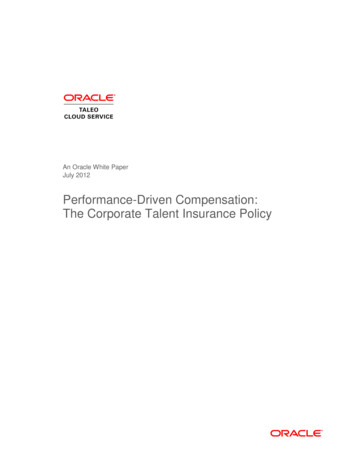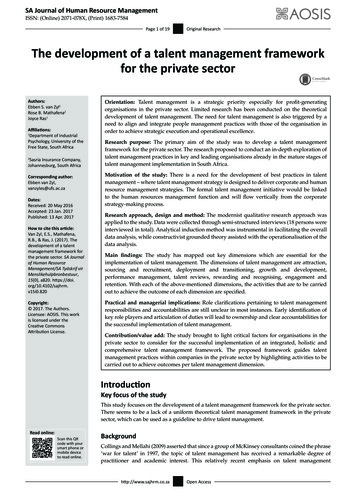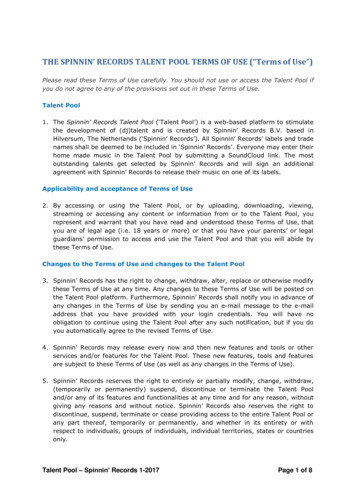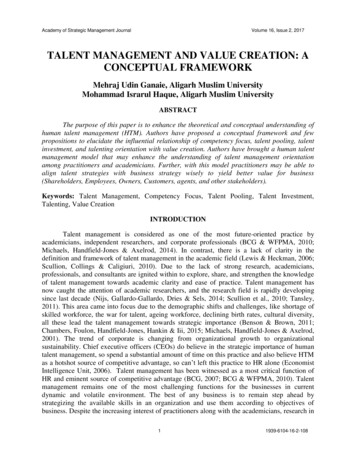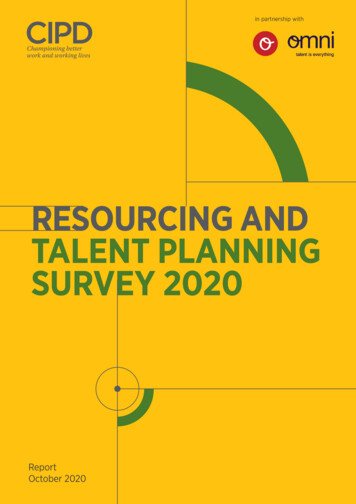
Transcription
in partnership withRESOURCING ANDTALENT PLANNINGSURVEY 2020ReportOctober 2020
The CIPD is the professional body for HR and people development.The registered charity champions better work and working livesand has been setting the benchmark for excellence in people andorganisation development for more than 100 years. It has more than150,000 members across the world, provides thought leadershipthrough independent research on the world of work, and offersprofessional training and accreditation for those working in HR andlearning and development.The CIPD’s Resourcing and Talent Planning survey, in partnershipwith Omni RMS, examines resourcing and talent planning practicesand the key challenges organisations are facing. It provides peopleprofessionals and their organisations with benchmarking data onimportant areas such as recruitment costs, employee turnover andretention. The survey for this 2020 edition was conducted online andsent to people professionals and senior HR leaders in the UK. In total,661 people responded.
Resourcing and talent planning survey 2020Report123Resourcing and talent planningsurvey 2020Contents41Foreword from the CIPD22Foreword from Omni33Summary of key findings54Resourcing and talent practices in the current climate95Recruiting: the numbers116Attraction strategies167Selection and candidate behaviour238Recruitment difficulties279Talent management, retention and turnover3110Background to the survey355678910AcknowledgementsThe CIPD and Omni RMS are incredibly grateful to the organisations and individualswho gave their time and expertise to provide feedback to help inform this report.These include: David Gawthorpe, Head of Resourcing, Stagecoach Group PlcHannah Gooch, Senior Talent Acquisition Manager, OVO EnergyJan Smallbone, Director of Learning and Talent Development, Mitchells & ButlersHelen Starkey, Head of Strategic HR, Crown Prosecution ServiceJo Taylor, Talent Expert, Let’s Talk TalentSteve White, Head of Resourcing and Workforce Planning, Crown Prosecution ServiceSandy Wilkie, Associate, Greenhill HR and Talent.Thanks also to Annette Hogarth, research consultant, for analysing the findings andwriting the report.Publication informationWhen citing this report, please use the following citation:CIPD. (2020) Resourcing and talent planning survey 2020. London: Chartered Instituteof Personnel and Development.1
Resourcing and talent planning survey 2020112345678910Foreword from the CIPDThe CIPD’s Resourcing and Talent Planning survey, in partnership with Omni, is now in itstwenty-first year. It is a valued survey with a sample this year of over 650 HR professionals.This is a challenging time for organisations experiencing the continued global impact ofthe COVID-19 pandemic. On top of that, the UK’s transition period for leaving the EU willend on 31 December 2020, bringing with it implications for organisations and recruitmentand talent practices.Our survey shows that COVID-19 has had an abrupt impact on the economy, workforceand resourcing activity: almost a third of organisations have decreased their recruitmentactivity and over half have put it on hold. Almost two in five anticipate a reduction intheir recruitment budgets in 2020–21. In response to this ever-challenging backdrop, ourfindings suggest the importance of organisations focusing on the following four key areas.Taking a strategic approach to talent managementThe challenging climate, more than ever, requires organisations to take a strategicapproach to their talent management and regularly evaluate their practices. Reassuringly,more than three in five organisations take a strategic approach to recruitment as part ofa wider talent management/people strategy, but few organisations take a comprehensivedata-based approach to improving their resourcing decisions. Few organisations currentlycollect and use good-quality data to forecast hiring demands, or assess the availability/supply of talent in the market. Furthermore, fewer than two in ten currently measure thereturn on investment of their recruitment processes.Broadening and diversifying talent poolsTwo in five organisations have recruited a more diverse workforce over the last 12 monthscompared with the previous year and over half have a formal diversity strategy. However,our findings suggest that most could improve the inclusivity of their recruitment processesthrough a more comprehensive approach that includes measures to eliminate bias. Ourfindings also show considerable variation in efforts to attract diverse candidates to boardlevel. Nearly two in five report that their organisation is only slightly active or not at allactive in this area. Organisations need to place more focus on ensuring greater diversitythroughout their organisations and that diversity and inclusion is a continued focus ratherthan an ad hoc effort.Developing skills in-houseThe challenging backdrop also means that organisations will need to place more emphasison developing talent in-house. Skill shortages and lack of relevant experience are commoncauses of organisations’ recruitment difficulties. Encouragingly, many organisationsare responding through developing more talent in-house, including upskilling existingemployees to fill hard-to-recruit-for positions and sponsoring relevant professionalqualifications. Developing talent in-house enables organisations to tailor programmes tomeet their specific skill requirements, decrease their reliance on the external labour marketand reduce recruitment and retention costs.A considered use of technologyFinally, organisations are increasingly using technology to attract candidates. The topmethods they find effective are their own corporate website and professional networkingsites, such as LinkedIn. The proportion using technology to conduct interviews hascontinued to grow and more organisations are also conducting tests/assessments online.It’s important, however, that tech recruitment solutions are tested to make sure they aren’t2Foreword from the CIPD
Resourcing and talent planning survey 202012345disadvantaging candidates and that they’re accessible to all. While technology itself is nota fix-all, the considered application of appropriate technologies can be hugely beneficialand cost-effective in improving recruitment processes.Moving forward, organisations need to continue to develop a thorough understandingof their existing talent profile and their current and future requirements. Collecting andevaluating data, and strengthening approaches based on the insights gained, is criticalto maximise the effectiveness and efficiency of resourcing strategies. It is also importantto join up talent management practices in a strategic way from recruitment through todevelopment, progression and retention.With the economic downturn intensifying pressure on resources, organisations will faceincreased impetus to ensure their people investments deliver in terms of performance andretention.6Claire McCartney,Senior PolicyAdviser, Resourcingand Inclusion789102Foreword from OmniWe are pleased to partner with the CIPD to produce this crucial report that providesinvaluable insight into resourcing and talent planning trends at this critical point in ourhistory.Before the world unwillingly entered into life with COVID-19, the outlook for the UKeconomy and employment was looking positive, despite uncertainty over Brexit andits anticipated impact. The UK had reached its lowest levels of unemployment sincethe 1970s, with an applicant-driven market where the choice in roles meant they couldcommand more competitive salaries, flexible working patterns, stronger training supportand a full career development plan. Few could predict how our world could change in amatter of months.This year’s report comes at a time when economists are predicting unemployment torise to between 9.7% and 13.2%, with the impact of Brexit still unclear, IR35 legislativechanges imminent, and the effects of globalisation, digitalisation, an ageing workforceand the dynamics of multi-generational workplaces besides. We enter this new worldwhere existing approaches to workforce management are no longer fit for purpose. Thisreport reveals how companies are adjusting their talent strategies to meet the shiftingdemands rather than simply reverting to the strategies that served them well prior to thelast economic crisis.While there remain areas for continued attention, the findings give insight into the generallyprogressive practices that enable others to learn, plan and be prepared for the challengesahead. With the current talent paradox of a surplus of applicants for some roles and acontinued shortage in others, it’s encouraging to see ‘world class’ resourcing strategiesbeing increasingly adopted. Going forward, the key areas of focus should include:3Foreword from Omni
Resourcing and talent planning survey 202012345678910 Strategic resourcing. Few organisations are taking a data-based approach toresourcing decisions and only measuring traditional KPIs as opposed to those thatprofit-enable a business and measure ROI. Internal mobility. Organisations are making significant progress in planning how tofill future leadership and hard-to-fill niche roles. The development of career pathswith more inclusive and challenging experiences to enable career growth, greatersuccession planning management and an increase in early career and mid-careerprogrammes is a positive shift, but the challenge now for businesses is to protectbudgets for these enablers for future success. Attraction and retention. While the use of more diverse and wider attractionstrategies was a positive finding, there still appears to be a disconnect betweenattraction and retention, with few companies using data gleaned from leavers toinform resourcing decisions. Brand and candidate experience. In our new world, building trust and a lasting culturewhen so many teams are working virtually is a real challenge for both hiring andengaging employees. The key lesson is to ensure technology is adopted carefully andcomplements an organisation’s brand and values and is optimised with the end-userexperience in mind. Inclusion. Despite some positive findings, it is surprising that only a half oforganisations have a formal diversity strategy. While progress is being made inpockets, fully aligning brand, attraction, selection, hiring manager training, onboarding,retention and ongoing career progression will give organisations full visibility of whatis and isn’t working so they can make informed changes.Companies and leaders, with their eye on the future, will recognise that the powerfulforces shaping our future economy and world of work require them not to pause, butto accelerate. Leaders should reshape their talent strategies now to ensure they attract,develop, and retain the best talent and apply the same rigour, effort and sophisticationto resource planning as is given to designing overall business strategy. Developingstrategic partnerships to offer expertise, agility and pace while living up to businessvalues and their employee value proposition will be critical during these times.Louise Shaw,Director ResourcingTransformation4Foreword from OmniMartin Wainman,Managing Director
Resourcing and talent planning survey 2020312345678910Summary of key findingsA challenging climate Prior to the COVID-19 pandemic, the UK was experiencing its highest employmentrate on record. The median number of permanent (30) and short-term (8) vacanciesorganisations tried to fill in 2019 is the highest shown in this survey for a decade. Nearly three-quarters of respondents report increased competition for talent and changesin the skills needed for jobs. Most experienced recruitment and retention difficulties overthe last 12 months. Professionals/specialists and technical posts remain the most difficultpositions to recruit for and retain, but more organisations report difficulties recruiting andretaining employees in all role levels compared with previous years. COVID-19 has had an abrupt impact on the economy, workforce and resourcing activity:32% have decreased recruitment activity and 57% have put it on hold. Thirty-nine percent anticipate a reduction in their recruitment budgets in 2020–21. A small proportion of organisations (14% overall, rising to 29% of the public sector)have increased their recruitment activity as a consequence of the pandemic. Nineteenper cent have increased training and 14% have increased their focus on retaining talent.Fifteen per cent of respondents anticipate an increase in their recruitment budget for2020–21.Implications and recommendations for practitionersWith ongoing uncertainty about the continued impact of COVID-19, organisations needto ensure they have the skills required for new ways of working and the agility to keepbusiness-critical operations running through employee shortages or reductions. As we faceup to another recession, many organisations will need to manage or reduce workforcecosts while ensuring they nurture and retain the talent required to negotiate and recoverfrom the downturn.Organisations will also need to anticipate and prepare for the continued impact ofBrexit on their resourcing and talent planning activities. Employers who employ EUnationals should carry out an audit of their workforce to assess where the future labourand skills shortages may lie and how they might address them. Alongside some of thekey recommendations in this report, some low-wage employers may also wish to lookat alternatives, such as automation, given the disproportionately large impact the newrestrictions will have on their ability to recruit from overseas. Meanwhile, higher-wageemployers need to get to grips with the cost, administrative and legal implications of thenew system that is due to be introduced in January 2021.1 Develop your workforce planning skills and activities. What are your business-criticalroles and are there any gaps that you need to fill or develop people into? Have you gotan up-to-date skills inventory?2 What is the ratio you usually work to in terms of external recruitment and internaldevelopment?3 What is the ratio you usually work with in terms of permanent versus contingentworkforce (contractors or temps)?4 How might these ratios need to change as a response to the challenges of Brexit andthe wider economic downturn?5 When thinking about recruitment more specifically, what are the key roles that you needto recruit for and that would make the biggest difference to your business?6 Collect and make good use of resourcing data and evidence to justify spend whenbudgets are limited.5Summary of key findings
Resourcing and talent planning survey 202012345678910Broadening the pool of potential candidates Organisations are casting the net wider in their search for talent. Forty-one per cent haverecruited from a wider geography over the last 12 months compared with the previous year,and 44% have targeted passive candidates in their efforts to reduce recruitment difficulties. Many are also turning to candidates from other sectors/industries or those withpotential but without experience. In-house training and skill development initiativesenable consideration of a wider pool of candidates. Nineteen per cent offer careerreturner programmes and 16% mid-career change programmes. Forty-one per cent have recruited a more diverse workforce over the last 12 monthscompared with the previous year. Overall, 52% have a formal diversity strategy, althoughmost take some steps to recruit a diverse range of candidates.Implications and recommendations for practitionersIt is positive that organisations are taking a more flexible approach to recruitment andtaking steps to recruit a more diverse range of candidates through their recruitmentprocesses and skills initiatives. Nevertheless, our findings suggest that most could improvethe inclusivity of their recruitment processes through a more comprehensive approach thatincludes measures to eliminate bias and organisations could be more progressive, withless than a quarter operating policies that go beyond basic legislative requirements onprotected characteristics.Our findings also show considerable variation in efforts to attract diverse candidates toboard level. Nearly two in five (39%) report that their organisation is only slightly active ornot at all active in this area. The #BlackLivesMatter protests have brought into sharp focusthe racial inequalities within our societies and our workplaces. Organisations need to placemuch more focus on ensuring greater racial and, of course, broader diversity at the verytop of our organisations.1 Broaden your pool of potential candidates by varying your recruitment outreach andplacing more rigour, consistency and challenge in your recruitment and selectionapproaches.2 Ask questions about what is critical to the role. People from different industries orbackgrounds may have transferable skills and knowledge and can bring fresh insight.3 Build a strategic approach to attracting and developing diverse candidates to fill seniorpositions. Consider targeting attraction strategies for people with characteristics that areunder-represented in particular roles.4 Critically evaluate your organisation brand to see how attractive it is to diversecandidates. What changes can you make to your brand and your culture to help attract,select, develop and retain more diverse employees?5 Evaluate your recruitment activities to assess which are most effective in broadeningyour talent pools.6 Develop programmes like career returners and mid-career change to help broaden yourtalent pool and diversify people’s skills.Increasing use of technology in the recruitment process Organisations are increasingly using technology to attract candidates. The top methodsthey find effective are use of their own corporate website and professional networkingsites, such as LinkedIn. The proportion using technology to conduct interviews (68%) has continued to grow andmore organisations are also conducting tests/assessments online (35%, up from 23% in 2017). A substantial minority (43%) use applicant tracking systems but there has been loweruptake of other recruitment technologies.6Summary of key findings
Resourcing and talent planning survey 202012345678910 Respondents report that their use of technology in the recruitment process has resultedin a number of benefits, the most common being increased accessibility for candidates,a speedier recruitment process and improved candidate experience. A fifth, however,believe their use of technology has resulted in a more impersonal candidate experience.Implications and recommendations for practitionersWhile more organisations are turning to technology to attract candidates and facilitatethe recruitment process, our findings show that the extent to which they use the range oftechnologies available varies, as does its results. It’s very important that tech recruitmentsolutions are tested and deployed to ensure they’re not disadvantaging candidates andthat they’re accessible. While technology itself is not a fix-all, the considered applicationof appropriate technologies can be hugely beneficial and cost-effective in improvingrecruitment processes, candidate experience and the quality of hires.It is likely that one of the longer-term impacts of COVID-19 will be a greater utilisation oftechnology to allow remote selection and onboarding of employees and an increase inhomeworking in the future. In addition, with the increased volume of candidates, recruiterscan use technology to support the management of a higher volume of candidates. It istherefore important that organisations invest in the right technology and apply lessonslearned from their use of virtual recruitment tools and make the process as effective asthey can for candidates and the organisation alike.1 Continue to evaluate and improve your use of technology. Ask candidates and hiring managersfor feedback and act on that feedback. Provide feedback to candidates, where possible.2 Review the impact of your use of technology in recruitment on the diversity of yourhires and the number of suitable versus unsuitable candidates for your positions.3 Consider making better use of tools to enable self-selection such as pre-applicationassessments, and technologies such as chatbots to potentially reduce the number ofunsuitable candidates for roles.4 Ensure that any technology you use emphasises your individual employee valueproposition and uses diverse role models.5 Also make sure that your technology is future-proofed as far as possible.A stronger focus on developing skills in-house Skill shortages and lack of relevant experience are common causes of organisations’recruitment difficulties. Many organisations are responding through developing moretalent in-house, including upskilling existing employees to fill hard-to-recruit-forpositions (69%) and sponsoring relevant professional qualifications (63%). Our findings this year also show a small increase in the proportion of organisationsoffering apprenticeship programmes and intern schemes, and a more substantialincrease in the proportion offering post-A-level entry routes. Increasing learning and development opportunities is also the most common step takento improve retention.Implications and recommendations for practitionersDeveloping talent in-house enables organisations to tailor programmes to meet their specificskill requirements, decrease their reliance on the external labour market and reduce recruitmentand retention costs. In times of crisis, learning and development activities are often hard hit,precisely when the ability to adapt, learn and improve is particularly imperative.Our findings confirm that budgets for the year ahead have been affected, with twice asmany organisations anticipating a decrease (32%) than an increase (16%) in their talentmanagement budget for 2020–21 – a reversal from previous years. These more straitened7Summary of key findings
Resourcing and talent planning survey 202012345678910times will require innovative solutions to support new ways of working and enhanceemployee and organisational effectiveness.1 Don’t take your focus off internal skill development in these difficult times – it will helpsupport retention and hold you in a more competitive position as the wider economicpicture starts to slowly improve.12 Protect your budget for strategic learning and development – initially focus on investingin the areas most important to the organisation and in filling potential skills gaps. Thisinvestment will help you continue to adapt and improve.3 Think about introducing development opportunities that bring great learning butthat don’t necessarily cost the earth, such as work-shadowing, mentoring and crossfunction project working. You may also like to consider digital options for internal skilldevelopment.4 Continue to invest in ways for young people to access opportunities in your organisationsuch as apprenticeships, traineeships, industry placements and post-A-level routes, andkeep up to date with new products and routes.5 Technological change means that employers increasingly depend on highly transferablecore skills, such as communication, teamworking and problem-solving. Ensure that skillsdevelopment programmes address these ‘essential’ skill gaps as well as technical/jobspecific skill gaps.How strategic are organisations in their approach to talent management? Sixty-five per cent of organisations take a strategic approach to recruitment as part ofa wider talent management/people strategy, but fewer (48%) report that their CEO hastalent management as a key priority. Few organisations take a comprehensive data-based approach to improving theirresourcing decisions. Only 14% collect and use good-quality data to forecast hiringdemands, and 8% assess the availability/supply of talent in the market. Nineteen percent currently measure the return on investment of their recruitment processes. Positive findings this year show that more organisations are taking steps to tackleretention. Nevertheless, while 83% collect data to identify retention issues within theirorganisation, only 30% use the data to inform resourcing decisions and even fewerevaluate the effectiveness of retention initiatives.Implications and recommendations for practitionersOrganisations need to develop a thorough understanding of their existing talent profile andtheir current and future requirements. Collecting and evaluating data, and strengtheningapproaches based on the insights gained, is critical to maximise the effectiveness andefficiency of resourcing strategies. With the economic downturn intensifying pressure onresources, organisations will face increased impetus to ensure their investments deliver, notjust in terms of cost per hire but also in terms of performance and retention.1 Align your recruitment strategy with your wider approach to talent and peoplemanagement.2 Put a range of robust measures in place to assess the return on investment of yourrecruitment activity (such as cost per hire, performance and turnover rates of newhires as well as overall effectiveness of attraction methods). With recruitment budgetsincreasingly constrained, it is more important than ever to ensure this is being spent inthe most effective way.18The CIPD’s Creating learning cultures: assessing the evidence report iterates the importance of L&D during COVID-19.Summary of key findings
Resourcing and talent planning survey 2020123456789103 Take a comprehensive data-based approach to improving all your resourcing decisions.Collect and evaluate data and strengthen approaches based on the insights gained.4 Collect data to identify retention issues and use that data to evaluate the effectivenessof your retention strategies and to inform resourcing decisions going forward.5 Understand the aspirations of your people as this can help target development and aidretention. Make sure managers know and are interested in the development needs andcareers of their team members.4 Resourcing and talent practicesin the current climateKey findings There has been a slowdown in recruitment activity in response to the COVID-19pandemic. Our survey findings (one to two months after full lockdown was imposed) alsoreveal the huge impact on current employees: 10% of organisations report temporaryclosures of their business, 9% have made redundancies, 18% have reduced employees’working hours, 39% have put employees on paid leave and 8% on unpaid leave. A small proportion have increased training (19%) or their focus on retaining talent(14%) as a consequence of the pandemic. Nearly three-quarters of respondents report that competition for well-qualifiedtalent has increased over the previous year and almost as many that the skillsneeded for jobs in their organisation are changing. Many have been responding by developing more talent in-house (62%), recruitingfrom a wider geography (41%) and recruiting a more diverse workforce (41%).COVID-19 pandemic’s dramatic impact on resourcing activityOur 2020 survey went live one month after the COVID-19 lockdown. The dramaticimpact of the pandemic on resourcing activity is shown in Figure 1. Overall, nine in tenrespondents report that COVID-19 has had an impact on their resourcing and workforceplanning activities, with private sector organisations most affected (93% compared with89% of not-for-profit and 85% of the public sector).The forced closures of businesses and required rearranging of working patterns have had asignificant impact on the workforce. The Government’s Coronavirus Job Retention Schemehas helped prevent many redundancies to date, but 12% of private sector respondentsreport that redundancies have been made (2% of non-profit and 0% of the public sector).Most report that recruitment activity has been put on hold (57%) or decreased (32%),although a small proportion (14%) have increased recruitment activity in response to thepandemic. Public sector organisations, most likely to still be operating as essential serviceswhile coping with increased employee absence, are most likely to have increased theirrecruitment activity (29% compared with 11% of non-profits and 10% of the private sector).Around one in five organisations have increased training as a consequence of thepandemic. Organisations need to ensure that employees and managers are equipped withthe skills required for new ways of working and that they have adequate transferrable skillsto keep business-critical operations running through employee shortages.9Resourcing and talent practices in the current climate
Resourcing and talent planning survey 202012Supporting employees and retaining talent throughout the crisis will be key to ensuringorganisations are in a good position to adapt and recover. Despite this, only a minority(14%) have increased their focus on retaining talent.Figure 1: Impact of COVID-19 on resourcing and workforce planning (%)3We have put our recruitment activity on hold57We have increased our focus on retaining talentImpact ofCOVID-19We have increased our recruitment activityWe have had to temporarily close our business107We have increased trainingWe have reduced working hours of our employees1061039959We have decreased our recruitment activity848We have put employees on paid leave3214COVID-19 has not impacted on ourresourcing and workforce planning activitiesWe have made redundancies1914We have put employees on unpaid leave18Base: n 651Organisations developing more talent internally, recruiting more widelyIn the months prior to the pandemic, the UK was experiencing its highest employment rateon record.2 Nearly three-quarters of respondents report that competition for well-qualifiedtalent had increased over the previous year and a similar proportion that the skills neededfor jobs in their organisation are changing (Figure 2). Respondents are twice as likely t
Resourcing and talent planning survey 2020 1 Foreword from the CIPD The CIPD's Resourcing and Talent Planning survey, in partnership with Omni, is now in its twenty-first year. It is a valued survey with a sample this year of over 650 HR professionals. This is a challenging time for organisations experiencing the continued global impact of
